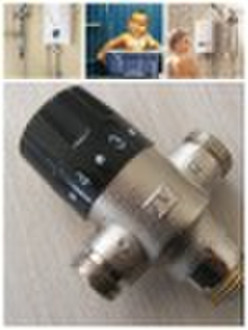太阳能热喷泉中的温混合阀门
原价: 17,00 USD
沉阳市, 中国
生产能力:
5000 片 / 月

Bob Liu
联系人姓名
基本信息
1.Technical Data a.Working pressure:0.03-1Mpa b.Ideal working pressure:0.1-0.5Mpa c.Maximum working Temp.:Below 99C d.Cold water Temp. range:5-29C e.Hot water Temp. range:50-95C f.Outlet Temp. range:35-45C g.Adjustment Accuracy:+/- 2C h.Flow rate on 1 bar pressure drop:11.67L/min i.Connection:Inlets-M, Outlet-M Flow rate for pressure:Pressure(psi or kPa)1 psi5 psi(34kPa)10 psi(69kPa)15 psi(103kPa)20 psi(138kPa)30 psi(207kPa)Flow Rate(liters per minute)4.5912.515.117.628.2GPM0.982.02.73.33.96.22.Materials of Constructiona.Valve body:Brass with Ni-plated b.Shutter:PPO c.Spring:Stainless steel d.O-ring:EPDM 3.Features: a.Fail-safe on Hot or Cold Supply Failure b.Delivers Stable Mixed Water Temperature c.Extended Mix Temperature Range:35-45 C d.Idea for Domestic Water e.Tamper-Proof Cap 4.What is the thermostatic mixing valve? A Thermostatic Mixing Valve is a valve that blends hot water (stored at temperatures high enough to kill bacteria) with cold water to ensure constant, safe outlet temperatures preventing scalding. They shut-off rapidly in the event of a hot or cold supply failure to prevent scalding or thermal shock. TMVs accurately control water temperatures for bathing, showering and hand-washing. They maintain pre-set temperatures - even if water pressure varies when other appliances are used. TMVs can be fitted under baths and basins, be part of shower fittings, or as a feature of exposed hot and cold water mixers. 5.Usage of TMVs Point of use mixing for wash hand basins, bidets, baths and showers in hospitals, schools, sport and leisure facilities, prisons and other public buildings.6.Installation Precaution: a.All installations should be carried out by a Licensed Professional. b.Install in accordance with markings on valve body. i.e. hot water inlet-marked H, cold water inlet-marked C. c.After temperature setting, if inlets temperature or pressure fluctuates, outlet temperature variation is within+/-2C. d.The external check valves at inlets prevent cross-flow of hot&cold water when inlets pressure is not the same. e.If the ratio between two inlets is too large, one flow-limiting valve should be fixed at the side of higher pressure. f.Prior to installation, provisions should be made to flush the piping of any debris or other foreign materials to ensure proper system operation. 7.How They Work? Upon use of tempered water, a thermostat in the mixing chamber of the valve senses the outlet temperature. The thermostat automatically positions a seat assembly which controls the flow of hot and cold water supplied to the mixing chamber. If the mixed outlet temperature increases, the thermostat will expand moving the seat assembly to allow the cold water inlet port to open more fully and at the same time restricting the hot water inlet port. Conversely, if the mixed outlet temperature decreases, the thermostat will contract moving the seat assembly to allow the hot water inlet port to open more fully and at the same time restricting the cold water inlet port. In both cases the mixed outlet water temperature is automatically and continually maintained at the preset temperature within the tolerances of the valve. In the event of a cold or hot water supply failure, the seat assembly moves to an extreme position shutting off the hot or cold inlet water port. A mechanical adjustment permits selection of the desired outlet water temperature within range of the valve.8.Installation Precaution:a.All installations should be carried out by a Licensed Professional. b.Install in accordance with markings on valve body. i.e. hot water inlet-marked H, cold water inlet-marked C c.After temperature setting, if inlets temperature or pressure fluctuates, outlet temperature variation is within+/-2C. d.The external check valves at inlets prevent cross-flow of hot&cold water when inlets pressure is not the same. e.If the ratio between two inlets is too large, one flow-limiting valve should be fixed at the side of higher pressure. f.Prior to installation, provisions should be made to flush the piping of any debris or other foreign materials to ensure proper system operation.9.Relationsships between TMVs and Legionella:Legionella is the bacteria responsible for Legionnaires Disease, an acute bacterial infection of the lower respiratory tract. This bacterium was first identified in 1977 by the Centers for Disease Control as the cause of an outbreak of pneumonia that caused 34 deaths at a 1976 American Legion Convention in Philadelphia. Pontiac Fever is a less severe, non-pneumonia, flu-like disease that is associated with and likely caused by Legionella bacteria. Legionella is a fairly common water bacteria and has been found to exist widely in many surface water sources such as; lakes, rivers, streams and ponds. It can also be found in ground water sources and some soils. At the levels found in these naturally occurring sources it typically does not pose a threat to public health. When the bacterium enters a domestic water systemIt can find an ideal host environment of warm water temperatures (40-46Celsius degree), stagnant water areas (storage tanks and dead-end piping legs) and ample food sources (sediment, scale, deposits and biofilm). Under these conditions Legionella can rapidly colonize, forming higher concentrations that can pose the public health threat of Legionnaires Disease.There are many methods of controlling colonization of Legionella bacteria. However, a widely accepted and preferred method is to maintain the hot water system storage temperature continually at or above 60C. Unfortunately, the elevated temperature necessary to minimize the growth of and kill Legionella bacteria has the potential to cause serious thermal shock and scalding injuries.Shenyang Beixin Energy Saving Equipment Co.,LtdContact: Mr. Bob LiuMobile ph#:86-13898845136
交货条款及包装
Packaging Detail: Carton2 pcs packaging(mm):150*87*52, small carton20 pcs package(mm):310*245*130, middle carton60 pcs package(mm):470*315*190, big carton Delivery Detail: 5-45days
端口: Dalian
付款条款
Telegraphic transfer
Western Union
-
支付方式
我们接受:









